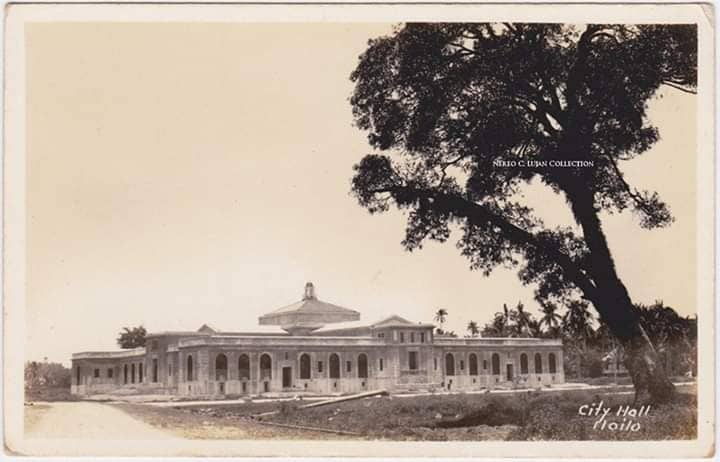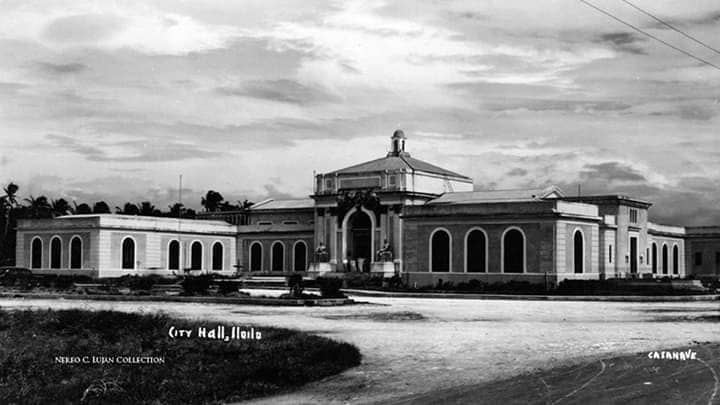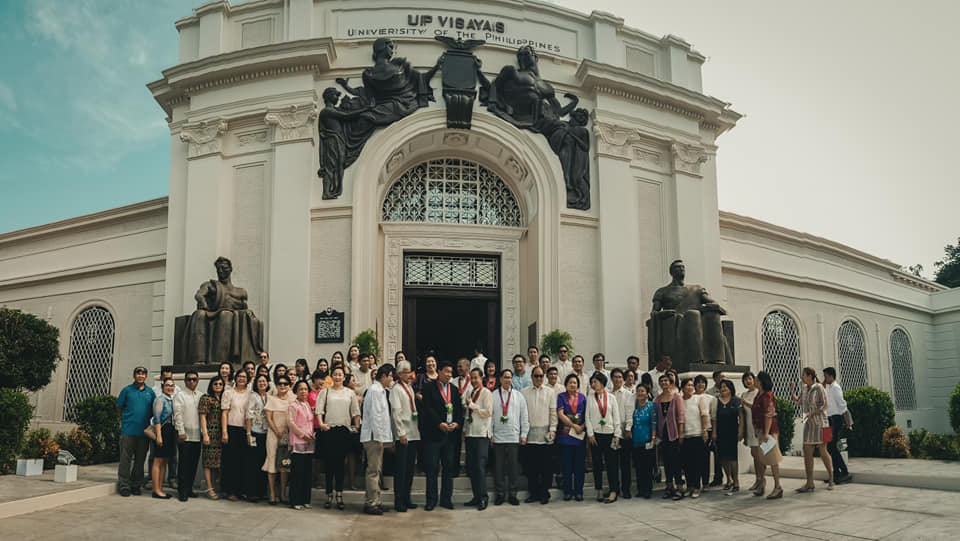The building that is now the UP Visayas Museum Complex celebrates 86 years old this year. It was officially inaugurated in 1936 upon the declaration of Iloilo as a chartered city by House Bill 2368 authored by Guimarasnon lawmaker Cresenciano M. Lozano.
The neo-classical Art Deco building has evolved from being the Ayuntamiento or town hall of Iloilo to a school that is the University of the Philippines, and down to the Galería de Arte or art gallery and museum complex today.
It served as the Iloilo Town Hall from 1936 to 1947 and as the Main Building of UP Visayas in the Iloilo City campus until its restoration work in 2017 through a P54-million grant appropriated by the National Historical Commission of the Philippines (NHCP). It was uplifted to become the UP Visayas Museum Complex after the Commission on Higher education (CHED) granted the proposal in 2019.
Its new name is roughly three years old, as such, a mere mention of “UP Visayas Museum Complex” is understandably confronted by a question – where is that? As if one had been out from Iloilo City or UP Visayas, for that matter, for half a century.
From UPV Main Building to UP Visayas Museum Complex
The Museum Complex is not a new structure. It is commonly referred to as the Main Building of UP Visayas in the years that succeeded the official turnover of the town hall to the University of the Philippines through a Deed of Donation from the Iloilo City Government.
From then onwards, the Main Building served various significant purposes to the UP Visayas community,
Its four grand entry and exit points were then passageways for students, teachers, and staff either going to classes or laboratory work; to have a health and dental check at the clinic; to study at the library; to process academic requirements at the offices, or to attend meetings in one of its rooms.
It is also worth mentioning, that this is also the place where you run to have a health break and enjoy the cold classic restroom atmosphere – high ceiling, above-the-head fittings, clogged drains, and the familiar pungent smell.
Read: INSIDE the UP Visayas Museum in Iloilo
Not too long ago, you’ll find under its roof the University Library upon entering the main atrium with a heavy wrought iron gate; study cubicles in the hall way; bulletin boards of student organizations; the former Dean’s Office of the College of Arts and Sciences at the right wing; and, make no mistake getting lost on the left wing, this is where you’ll get to smell various chemicals used for laboratory experiments.
In addition, it also housed the Center for West Visayan Studies, the UP BIDANI, and the UPV Art Gallery, among various big and small offices.


If only the walls and ceilings of the building can speak up, it will certainly reveal many interesting and mysterious events that took place in its romantic alleys, nook and cranny, rooms and laboratories, and share stories of love and loss, of triumphs and defeat, of success and frustrations, and everything in between that made academic life memorable.
Jopson’s idea of a stately town hall is more than a century old
The Ayuntamiento was envisioned as far back as 1906 by then Municipal President Rosauro Jopson. An account by Dr. Randy M. Madrid’s Historical Documentation of the UP Visayas Main Building puts the idea of establishing a stately town hall by Jopson on 1908.
It took 23 years after its conceptualization, however, to start the groundwork which started with the donation of the 10.8 hectares lot for the building site by Doña Juliana Melliza of Molo in 1929.
Consequently, it took another six years to finally see the building completed. The construction commenced in February 1931, finished in 1935, and was opened in 1937 during the celebration of Iloilo City Charter Day.
Read further here: Iloilo The Most Noble City
The building was envisioned as an architectural masterpiece. It was the famed Filipino Architect Juan Arellano who conceptualized the building design, while sculptural decorations were executed by the famous Italian sculptor Francesco Monti and assisted by local artisans.
Eventually, the whole property was donated by the Iloilo Council to the University of the Philippines to establish a Junior College in Iloilo during the term of Mayor Fernando Lopez.
Fast forward to today, all the intensive retouching work both on its interior and exterior was carried out starting in 2017 through a grant from NHCP facilitated by arts, culture, and heritage advocates at the senate: Sen. Franklin Drilon and Sen. Loren Legarda.
The reopening of the building on August 2019 wowed the public making the UP Visayas Museum Complex a site not to be missed by visitors to Iloilo City, especially those who have a heritage and arts and culture agenda.
Its neo-classic beauty was complemented with the relocation of the UP Oblation from its former site facing General Luna Street dimmed by a flyover to Delgado Street, the main thoroughfare of old Iloilo City and still one of the busiest streets.
The UP Oblation now stands regal in front of the Museum Complex and the open park is named Oblation Plaza, visible day and night by a walkable University Avenue from the main gate.
See featured photo at CLICK: UPV Oblation Plaza at sundown
While its halls stood silently during the pandemic, the gradual easing of lockdown has allowed the public to get reacquainted with the renovated structure in the last two years through visits by heritage architecture scholars, tourists, cultural students and workers, and art aficionados who would check out collections showed inside its galleries or attend shows on its Performing Arts Hall.
What was once the Ayuntamiento of Iloilo became the UPV Main Building and then transformed as Galería de Arte or the UP Visayas Museum Complex displaying its majesterial and aristocratic beauty.
Its doors will invite the new generation of people to appreciate its historical and cultural significance beyond the UP community perhaps for another century and for them to learn the noble and elitist character of Iloilo politics and society – a character that continues to hold sway until today as symbolized by this architectural landmark.
The building is an architectural masterpiece of Juan Arellano
Juan Arellano designed a very formal one-level structure with a neat row of arched windows. The design of the building is a composite of neo-classical and revivalist influences through Art Deco and nativist elements are predominating in its interior.
The main entrance dividing the horizontal plane into two equal parts echoed the arches of the windows and is flanked on either side by austere looking composite pilasters. It was capped with an interesting cupola or dome.
Arellano devised the façade to look more grandiose and interesting by letting his Italian friend Francesco Riccardo Monti, sculpt two seated bronze male statues representing the abstract concepts of Law and Order on either side of the entrance and a bas-relief of four figures above the arched opening.
It has two big patios and a wide court at the main entrance. The emphasis on compactness and dominance of its environs are highlighted in outside lines while space, ventilation, and lighting are given importance in the interior. The Neo-classic elements are apparent in the entire building: uniformly arched windows, stylized composite columns, high ceilings and dome, and wide patios. Interestingly, tropical and nativist features that are reflective of the Filipino Bahay na bato are also observable: wide sliding main windows, ventanillas, and raised wooden floors.
The centerpiece of the building is the Court Room and the Session Hall, also known as Lozano Hall, which was named in honor of Cresenciano M. Lozano, a Guimarasnon law-maker who authored House Bill 2368 granting Iloilo a status of a chartered city in 1937.
Juan M. Arellano is a famous Filipino architect whose designs endured the test of time. Among his masterpieces are the Manila Metropolitan Theater, Manila Museum of Fine Arts, Manila Central Post Office; and government structures like Negros Occidental Provincial Capitol, Cebu Provincial Capitol, and Cotabato Municipal Hall.
In Iloilo, the Arellano name is immortalized by the old Jaro Municipal Hall, which also underwent restoration, and the old Iloilo City Hall, now the UP Visayas Museum Complex.

Chronology of events: The history of UP Visayas Main Building[1]
The University of the Philippines Visayas has offered a summary of the long history of the building from the work of Dr. Randy M. Madrid, entitled: Historical Documentation of the UPV Main Building. The chronology of events offered significant details of the noble work undertaken by former leaders of Iloilo City and UP Visayas to establish the building and to preserve its historical and cultural significance for new and future generations to appreciate and learn its value.
- 1908 – The construction of a massive and splendid municipal hall was a dream by Municipal President Rosauro Jocson and members of the Iloilo Municipal Board. Municipal Councilor Rosendo Mejica proposed appropriation of funds for the building construction amounting to P21,183.00 The proposal was not materialized due to difficulty in looking for a suitable site.
- 1929 – Dona Juliana Melliza formally donated 10,000 square meters of her lot to the Municipal Government of Iloilo (February 28). Municipal President Eulogio Garganera and the Municipal Board formally accepted the donation (March 1).
- 1929 – Municipal Councilor Evelio Zaldivar suggested the presentation of the plan to the Bureau of Public Works in Manila for assessment and review, which was unanimously approved by the Municipal Board (March 20) The projected cost of building construction was P 90,000.00.
- 1931 – The Municipal Board convened with District Engineer Alejo Aquino upholding the original plan of building the municipal hall at the Melliza lot in Molo (September 3).
- 1933 – Engineer Aquino received the grant loan amounting to P50,000.00 from the director of the Bureau of Public Works (BPW) in Manila to start the building construction (January 20 and February 1).
- 1933 – The BPW sent Consulting Architect Juan Arellano, to survey the proposed site and make a detailed study of the soil, vegetation, and neighborhood developments in the area. He was tasked to give reports and suggestions to BPW to successfully carry out the City Beautiful Project based on the earlier plan he prepared for Iloilo City (February 14).
- 1934 – The first concrete was poured on the construction site (February 1).
- 1935 – The building construction was finished (February 4).
- 1936 – The Iloilo City Hall was inaugurated amid much fanfare and celebration. It was a double celebration during the Christmas season with the inauguration of the presidencia or the House of the People, and the elevation of the municipality of Iloilo into a chartered city (December 19-31)
- 1937 – Ramon Campos became the first city mayor of Iloilo City (July 16).
- 1942 – Mayor Maximino Jalandoni vacated the city hall during the Japanese Occupation of Iloilo City (April 18).
- 1942 – 1945 – The Japanese troops made the city hall their last garrison in Iloilo City.
- 1945 – Mayor Fernando Lopez and the Iloilo City Council passed Resolution 485 appealing for a Junior College of the University of the Philippines to be established in Iloilo (December 18).
- 1946 – Mayor Lopez occupied the pre-war city hall. The city council reiterated to the UP Board of Regents its request for the establishment of UP Junior College in Iloilo (February 21).
- 1947 – The city council unanimously approved Resolution 461 formally donating the pre-war city hall and its site of 10.8 hectares for the exclusive use of UP Iloilo College (April 8). The same year, the University of the Philippines Iloilo College (UPIC) was formally opened with Dr. Tomas Fonacier as the first Dean (July 1).
- 1948 – Iloilo City council’s Resolution 753 (July 14) and Resolution 782 (July 23) formally set the legal transfer of the city hall building and adjoining site from the city government’s ownership to the University of the Philippines.
- 1949 – Iloilo City Mayor Vicente Ybiernas and UP President Bienvenido Gonzales, made legal and definite the use of the city hall building and site by UPIC through the “Deed of Donation” signed by both parties (August 24).
- 1950 – Rehabilitation of the building through the effort of the Philippine-American War Damage Commission.
- 1975 – UPIC through UP President Onofre D. Corpuz received P150,000.00 from the national government for the repair and renovation of the Main Building. The amount was spent on the repair and repainting of Lozano Hall, classrooms, biological science laboratories, the walls of the Main Building, high school building, and auditorium.
- 2009 – The National Historical Institute declared the Old Iloilo City Hall (now the UP Visayas Main Building) as a National Historical Landmark on December 14, 2009.
- 2015 – Administrative Order 282A of Chancellor Rommel A. Espinosa created an AdHoc Committee for the preparation of a proposal for the refurbishment or improvement of the UPV Main Building. The committee was composed of Prof. Celia Parcon, Dr. Alicia P. Magos, Anna Razel L. Ramirez, Dr. Randy Madrid, Ms. Joyce Colon, and Ms. Lea Papilota, Architect Luis Rabut, Prof. Martin Genodepa, Prof. Nestor Yunque, and Dr. Evelyn Belleza.
- 2016 – The proposal committee chaired by Prof. Martin Genodepa received a letter January that year from NHCP that the rehabilitation of the UPV Main Building will be included in the 2017 Budget Proposal of the NCIP.
- 2017 – A Restoration Grant of P54 million was allotted by NHCP for the rehabilitation and adaptive re-use of the UPV Main Building through the facilitation of Sen. Franklin Drilon and Sen. Loren B. Legarda.
- 2019 – The NHCP turned-over the UPV Main Building to UP Visayas on August 16.
Sources & Credits:
[1] History of the UPV Main Building: https://www.upv.edu.ph/index.php/news/history-of-the-upv-main-building; with sources from the Historical Documentation of the UPV Main Building by Dr. Randy M. Madrid. Posted 16 August 2019 by Ms. AL Ramirez under News category, including old photos used in the article with prominent reference watermark with the name Nereo C. Lujan Collection.
[2] Photo of NHCP turnover to UP Visayas taken from the Facebook page of UP Visayas: https://www.facebook.com/U.P.Visayas.Official/photos.
[3] From Ayuntamiento to Galería de Arte, especially the latter, is not a text from the reference/s but of the writer, purposely for this article.
[4] Slideshow photos are of the author.